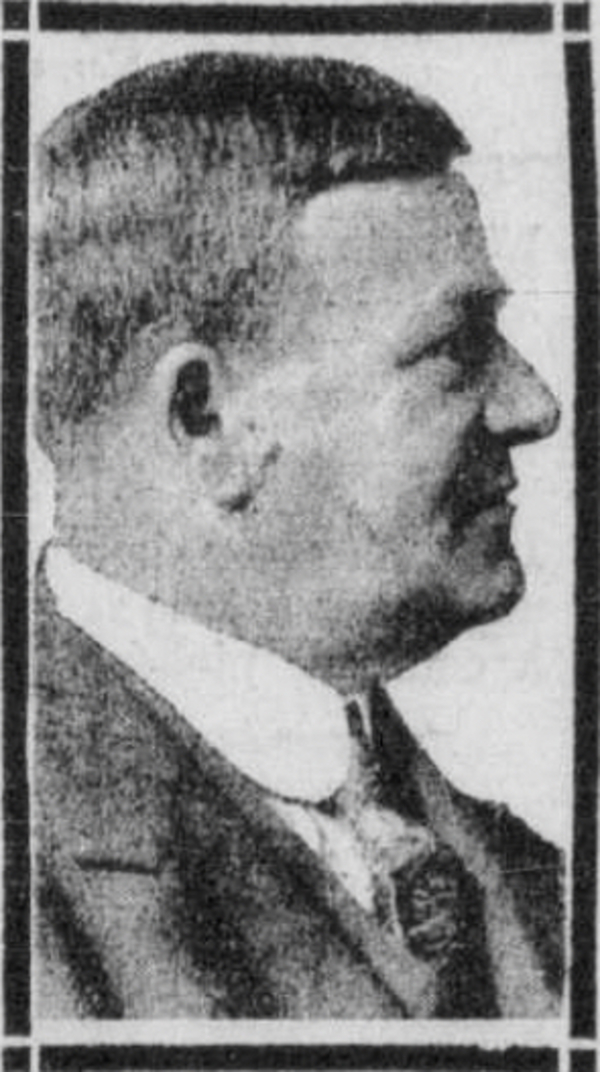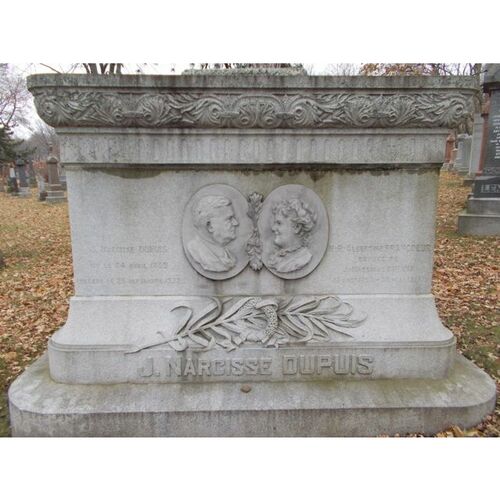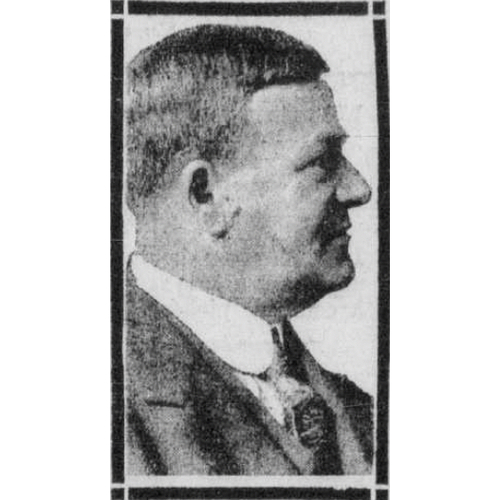
Source: Link
DUPUIS, JOSEPH-NARCISSE (baptized Narcisse), businessman; b. 24 April 1859 at Saint-Jacques-de-l’Achigan (Saint-Jacques), Lower Canada, son of Joseph Dupuis and Euphrasie Richard; m. first 26 Sept. 1882 Albertine Francœur (d. 30 May 1915) in the Montreal parish of Saint-Jacques, and they had 13 children, of whom 7 survived him; m. secondly 25 July 1917 Muriel Gertrude Barry in New York City, and they had a daughter; d. 25 Sept. 1932 in Montreal and was buried there three days later in Notre-Dame-des-Neiges cemetery.
Start of a dry-goods store
Joseph-Narcisse Dupuis began his education at the Collège Masson at Terrebonne in Lower Canada. Following the death of his father in 1864, he settled with his family in Montreal. It was probably at that point that he attended the Catholic Commercial Academy of Montreal. His eldest brother, Joseph-Nazaire*, opened a dry-goods store in 1868 at the corner of Rue Sainte-Catherine and Rue Montcalm. The business, known by about 1871 as J. N. et J. O. Dupuis, became a family affair, with his brothers getting involved early on. Like his elder siblings, Joseph-Narcisse worked there from a very young age (in his case when he turned 14). In 1882, after an interval during which he held a job in the wholesale and retail grocery store D. Masson et Compagnie [see Marc-Damase Masson*], probably between 1875 and 1880, he and his brother Alexis became partners in what was known as Dupuis Frères from 1877. They joined their brothers Joseph-Odilon and Louis-Napoléon, who had taken over management of the store after Joseph-Nazaire’s death in 1876. Also in 1882, the company moved to its permanent location at the corner of Rue Sainte-Catherine and Rue Saint-André.
Expansion
On 11 Nov. 1897 Joseph-Narcisse became sole proprietor of Dupuis Frères. Through his initiatives the firm experienced unprecedented expansion and evolved into a French Canadian department store. Between 1897 and 1900 Dupuis bought adjoining businesses to increase the size of the store. “Numerous goods of every description now take up ... 62,000 feet instead of 28,000,” reported La Presse on 8 Dec. 1900. The number of employees rose from 75 to 225, and sales grew by 150 per cent. Major renovations were undertaken and the number of departments multiplied to include furniture, kitchen and dining room furnishings, haberdashery, clothing, and jewellery. No effort was spared to turn Dupuis Frères into a department store comparable to Henry Morgan and Company Limited [see Henry Morgan*] and Eaton’s [see Sir John Craig Eaton*; Timothy Eaton*]: facilities were modernized, advertising and decoration emphasized, and new methods of managing human resources introduced. In 1904 the store occupied 85,000 square feet and employed close to 400 people; sales had climbed by 300 per cent since 1897.
In March 1908 Dupuis incorporated his company federally under the name Dupuis Frères (Limited) with a share capital of $500,000. He took the title of president and continued the expansion begun a decade earlier. Between 1910 and 1915 the firm added departments for appliances, books, religious articles, meat and vegetables, phonographs, and furs. In 1911 Armand-Joseph Dugal became the store’s managing director. His involvement seems to have been significant: within three years annual sales had increased considerably, from $493,012 to $1,413,513. The evocative slogan “Le magasin du peuple” (“The people’s store”) was attributed to him as well.
Dupuis Frères (Limited) styled itself a French Canadian business. In 1916, motivated by his patriotic values, Dupuis promoted the use of French with a gift of 50 gold medals awarded to final-year pupils in the Montreal Catholic School Commission system who had been most successful in studying the language. He was also instrumental in developing the store’s religious department, which stocked jewellery as well as vestments for clergy, with whom he maintained close ties and who would choose him as their exclusive supplier in the 1920s.
In 1919, with Dupuis’s support, 200 employees of Dupuis Frères (Limited) established a national Roman Catholic union. This organization, which was to occupy a central role in workers’ lives, created a mutual-aid fund for funeral expenses and costs incurred as a result of illness, and established a claims board. As in other department stores, women made up a large part of the workforce. For these working-class employees, the job of sales clerk was very respectable and instilled in them a deep sense of pride. They actively participated in the firm’s culture, which was influenced by domesticity and the ideology of separate spheres. The store also became a place for them to socialize.
In 1921 sales reached a little over $4 million and the company was incorporated (this time provincially) under the name Dupuis Frères, Limited, with a share capital of $4 million. The store also opened a postal outlet and began publishing a catalogue in French, which would enter the collective memory of countless consumers in Quebec. The same year, the firm sent out almost 20,000 copies of its 32-page catalogue promoting 587 items. Throughout several decades it would contribute to democratizing retail sales and changing purchasing habits in the province, especially in remote areas. The 1920s were a veritable golden age for Dupuis Frères, Limited and, generally, for western department stores, which fascinated customers with their sumptuous decor, window displays, sales, and special events. In 1923 the company took up residence in a new six-storey structure. “This building,” stated Le Devoir on 15 December, “brings to Dupuis Frères 116,000 feet of floor space, which added to the old stores’ 88,000 feet, amounts to 204,000 [feet].”
Decline and bankruptcy
Also in 1923, Dupuis sold all his assets to Dupuis Frères, Limited in exchange for $2 million of common shares. In 1928 his nephew, Albert Dupuis, son of Alexis, was elected president; Joseph-Narcisse then took on the position of honorary chairman, which he held until his death in 1932. From the Great Depression of the 1930s onwards, and particularly after the Second World War, department stores began to decline, slowly giving way to other types of large-scale retailers. The family spirit that Dupuis had established in Dupuis Frères, Limited began to erode substantially when the employees went on strike in 1952. Facing financial difficulties, the Dupuis family sold the business to private interests in 1961. Despite several attempts at recovery, the firm declared bankruptcy in 1978; 700 people lost their jobs.
Other activities
A Conservative in politics – he reportedly contributed about $200,000 to the federal party’s coffers – Dupuis was considered as a possible candidate for the 1926 federal election and, in 1932, for a seat in the Senate. From 1920 until his death, he was vice-president of the Imprimerie Populaire Limitée, which published Le Devoir, a nationalist Montreal daily founded by his close friend Henri Bourassa*. The two men enjoyed discussing foreign policy and modern history. A director of the Grand Trunk Railway and of the Montreal and Southern Counties Railway Company, Dupuis was also involved in charitable work: he sat on the boards of the St Vincent de Paul Society and Notre-Dame Hospital, among other organizations.
Assessment
Like most department stores of the time, Dupuis Frères, Limited had to endure much criticism – for the competitive threat it posed to small establishments, for example. Yet Joseph-Narcisse Dupuis’s entrepreneurial spirit enabled him to reach an enviable position in the Montreal business world. His decision to conduct his affairs in French in Montreal’s east end placed his company at the centre of the life and consciousness of thousands of French Canadians.
BANQ-CAM, CE601-S29, 2 déc. 1888; CE601-S33, 26 sept. 1882, 7 oct. 1883, 20 mai 1885, 24 févr. 1887, 3 août 1888, 17 sept. 1889, 18 févr. 1891, 10 mai 1892, 15 mars 1894; CE601-S51, 20 sept. 1889, 17 oct. 1891, 15 juill. 1899; CE601-S173, 2 juin 1895, 4 mars 1897, 3 sept. 1898; CE605-S31, 25 avril 1859. École des Hautes Études Commerciales, Service des arch. (Montréal), P049 (fonds de Dupuis Frères Limitée), A (administration générale), 3 (hist.). FD, Notre-Dame (Montréal), 11 juill. 1900, 16 nov. 1905, 2 juin 1915. LAC, R233-114-9, Que., dist. Laurier-Outremont (175), subdist. Outremont (56): 1. Le Canada (Montréal), 1er oct. 1904, 14 juin 1916, 11 mai 1932. Le Canard (Montréal), 10 juill. 1880. Le Devoir, 30 mai 1921; 2, 6 déc. 1922; 8 mai, 15, 17 déc. 1923; 24 nov. 1926; 10 mars, 6, 9 juill. 1928; 26 sept. 1932. Gazette (Montreal), 27, 28 July 1917; 21 July 1926; 26 Sept. 1932. Le Nouvelliste (Trois-Rivières, Québec), 21 juill. 1926. La Presse, 8 déc. 1900, 8 juill. 1917, 15 mars 1919, 23 mars 1923. Le Soleil, 9 déc. 1922. BCF, 1922. Émile Benoist, Monographies économiques (2e éd., Montréal, 1925), 3–10. Directory, Montreal, 1869–1933. Josette Dupuis-Leman, Dupuis Frères, le magasin du peuple: plus d’un siècle de fierté québécoise (Montréal, 2001). École des Hautes Études Commerciales, Service des arch., “Dupuis Frères Limitée: le magasin du peuple, 1868–1978”: web.archive.org/web/20200919142646/http://experience.hec.ca/dupuis_et_freres (consulted 4 Jan. 2021). Stéphanie Piette, “‘S’amuse bien qui s’amuse chez Dupuis’: la culture de travail des employées de Dupuis Frères entre 1920 et 1960” (mémoire de ma, Univ. de Montréal, 2012). Prominent people of the province of Quebec, 1923–24 (Montreal, n.d.). Statistics Canada, Department stores in Canada, 1923–1976 (Ottawa, 1979). John Willis, “Cette manche au syndicat: la grève chez Dupuis Frères en 1952,” Labour (St John’s), 57 (2006): 43–91.
Cite This Article
In collaboration with Stéphanie Piette, “DUPUIS, JOSEPH-NARCISSE (baptized Narcisse),” in Dictionary of Canadian Biography, vol. 16, University of Toronto/Université Laval, 2003–, accessed April 28, 2025, https://www.biographi.ca/en/bio/dupuis_joseph_narcisse_16E.html.
The citation above shows the format for footnotes and endnotes according to the Chicago manual of style (16th edition). Information to be used in other citation formats:
| Permalink: | https://www.biographi.ca/en/bio/dupuis_joseph_narcisse_16E.html |
| Author of Article: | In collaboration with Stéphanie Piette |
| Title of Article: | DUPUIS, JOSEPH-NARCISSE (baptized Narcisse) |
| Publication Name: | Dictionary of Canadian Biography, vol. 16 |
| Publisher: | University of Toronto/Université Laval |
| Year of revision: | 2022 |
| Access Date: | April 28, 2025 |





